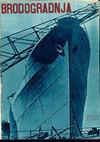用于改进船舶运动预测的四象限螺旋桨流体力学性能绘图
IF 3.9
4区 工程技术
Q1 ENGINEERING, MARINE
引用次数: 0
摘要
在迈向完全自主的海上舰艇的道路上,预测一艘舰艇在航行过程中的确切速度和位置,对无人艇向预定地点航行的动态定位、目标跟踪和自动驾驶操作起着至关重要的作用。本文探讨了自由运行的潜艇在直线航线上前进(激波运动)时的运行性能预测。除了向前推进的船只(直进运动)外,研究还涵盖了所有可能的船只激波情况,包括碰撞前进、碰撞后退和后退运动。由于在水动力性能图的所有四个象限中都缺乏螺旋桨数据,传统的操纵模型无法处理除前进运动以外的其他运动。本研究提出了一种方法,利用四个象限的螺旋桨性能和阻力测试数据来预测潜艇在所有这些浪涌条件下的性能。我们开发了一套内部代码 SMot4QP,用于在时域中模拟船速和位置。我们获得了令人满意的直线前进和碰撞前进运动的结果,而碰撞后退和后退机动由于螺旋桨尾流与船体的相互作用还需要进一步完善。所提出的方法能够利用船舶阻力和四象限螺旋桨测试结果预测所有类型船舶的运动。因此,在更广泛的海军应用中,SMot4QP 为运行性能预测提供了一种快速、稳健的替代方法,可替代计算成本高昂的自由运行自推进模拟。本文章由计算机程序翻译,如有差异,请以英文原文为准。
Four-quadrant propeller hydrodynamic performance mapping for improving ship motion predictions
On the path toward fully autonomous sea vessels, forecasting a ship’s exact velocity and position during its route plays a crucial role in dynamic positioning, target tracking, and autopilot operations of the unmanned body navigating toward predetermined locations. This paper addresses the prediction of the operational performance of a free-running submarine advancing in a straight route (in surge motion). Along with the forward advancing vessel (straight-ahead motion) the study covers all possible scenarios of ship’s surge, including crash-ahead, crash-back, and astern motions. Conventional maneuvering models cannot handle motions other than forward advancement due to the absence of propeller data in all four quadrants of hydrodynamic performance map. This study proposes an approach for predicting submarine performance in all these surge conditions by utilizing four-quadrant propeller performance and resistance test data. We developed an in-house code, SMot4QP, to simulate ship speed and position in the time domain. We obtained satisfying results for the straight-ahead and crash-ahead motions, while the crash-back and astern maneuvers require further refinement due to propeller wake interaction with the hull. The proposed method is capable of predicting the motions of all types of vessels using the ship’s resistance and four-quadrant propeller test results. Thus, SMot4QP offers a fast and robust alternative to computationally expensive free-running self-propulsion simulations for operational performance prediction in broader naval applications.
求助全文
通过发布文献求助,成功后即可免费获取论文全文。
去求助
来源期刊

Brodogradnja
ENGINEERING, MARINE-
CiteScore
4.30
自引率
38.90%
发文量
33
审稿时长
>12 weeks
期刊介绍:
The journal is devoted to multidisciplinary researches in the fields of theoretical and experimental naval architecture and oceanology as well as to challenging problems in shipbuilding as well shipping, offshore and related shipbuilding industries worldwide. The aim of the journal is to integrate technical interests in shipbuilding, ocean engineering, sea and ocean shipping, inland navigation and intermodal transportation as well as environmental issues, overall safety, objects for wind, marine and hydrokinetic renewable energy production and sustainable transportation development at seas, oceans and inland waterways in relations to shipbuilding and naval architecture. The journal focuses on hydrodynamics, structures, reliability, materials, construction, design, optimization, production engineering, building and organization of building, project management, repair and maintenance planning, information systems in shipyards, quality assurance as well as outfitting, powering, autonomous marine vehicles, power plants and equipment onboard. Brodogradnja publishes original scientific papers, review papers, preliminary communications and important professional papers relevant in engineering and technology.
 求助内容:
求助内容: 应助结果提醒方式:
应助结果提醒方式:


